chAPter 17
chapter 17 Managing Water: irrigation and drainage
Figure 17
Figur
.
e 17 3. Left: Sat
a ellite image
of southwest Kans
outhw
as, showing
as, sho
crop cir
cr
cl
op cir es from c
es fr
ent
om c er-pivo
er-piv t
irrigation s
a
y
tion s stems. Photo by
o b
NASA. Right: Groundw
. Right: Gr
a
oundw t
a er-
fed c
f
ent
ed c er-pivo
er-piv t sy
t s stem on a
pasture.
pastur
return on investment. The Imperial Irrigation District,
area—uses center-pivot irrigation systems supported by
located in the dry desert of Southern California,
located in the dry desert of Southern California, was
was
the large (174,
the large (174,000-square-mile) Ogallala aq
000-square-mile) Ogallala aquifer, which
uifer, which
developed in the 1940s with the div
developed in the 1940s with the diversion of water from
ersion of water from
is a relatively shallow and accessible water source (fi
is a relatively shallow and accessible water source (figure
gure
the Colorado River. Even today,
the Colorado River. Even today, large-scale irrigation
large-scale irrigation
17.3, left).
left). It is,
It is, however,
however, being used faster than it is
being used faster than it is
systems, like the GAP project in southeastern Turkey
recharging from rainfall—clearly an unsustainable prac-
(figure 17.
gure 17.2), are being initiated. Such projects often
are being initiated. Such projects often
tice. Deeper wells that require more energy—plus,
Deeper wells that require more energy—plus, more
drive major economic development efforts in the region
expensive energy—to pump water will make this mining
and function as a major source for national or inter-
of water an increasingly questionable practice.
national food or fi
national food or fiber production.
ber production. On the other hand,
On the other hand,
large dams also frequently have detrimental effects of
Recycl
y ed W
cl
ast
ed W e
ast w
e a
w t
a er
t
displacing people and flooding productive cropland or
displacing people and flooding productive cropland or
In recent years, water scarcity has forced governments
important wetlands.
and farmers to look for alternative sources of irrigation
water. Since agricultural water does not require the
Groundw
Gr
a
oundw t
a er
t
When good aquifers are present, groundwater is a
relatively inexpensive source of irrigation water. A sig-
nificant advantage is that it can be pumped locally and
cant advantage is that it can be pumped locally and
does not require large government-sponsored invest-
ments in dams and canals. It also has less impact on
regional hydrology and ecosystems, although pumping
water from deep aquifers requires energy.
water from deep aquifers requires energy. Center-pivot
Center-pivot
overhead sprinklers (fi
erhead sprinklers (figure 17.
gure 17.3, right) are often used,
right) are often used,
and individual systems,
and individual systems, irrigating from 120 to 500 acres,
irrigating from 120 to 500 acres,
typically draw from their own well. A good source of
groundwater is critical for the success of such systems,
and low salt levels are especially critical to prevent
Figure 17
Figur
.
e 174. Recycl
y ed wast
ed w ewa
w t
a er from the Cit
er fr
y of Adelaide, Austra
aide, Austr lia,
the buildup of soil salinity. Most of the western U.S.
is pumped into an irrigation pond f
a
or a v
tion pond f
eg
or a v etable farm. W
e f
ast
arm. W ewa
w t
a er-
conv
c
e
onv ying pipes are paint
ying pipes ar
ed purple to distinguish them from fr
o distinguish them fr
eshw
om fr
a
eshw t
a er
Great Plains—much of it part of the former Dust Bowl
conduits.
c
190
Building SoilS for Better CropS: SuStainaBle Soil ManageMent
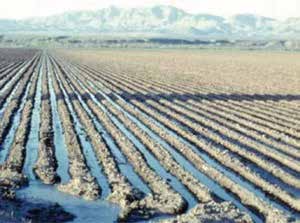
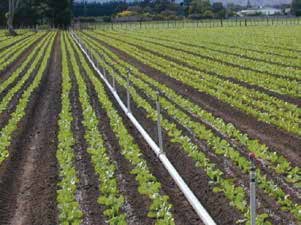
chAPter 17 Managing Water: irrigation and drainage
same quality as drinking water, recycled wastewater is
a good alternative. It is being used in regions where (1)
MAIn tYPes of IrrIGAtIon
densely populated areas generate significant quanti-
• Flood, or furrow, irrigation
ties of wastewater and are close to irrigation districts,
• Sprinkler irrigation
and (2) surface or groundwater sources are very limited
• Drip, or trickle, irrigation
or need to be transported over long distances. Several
• Manual irrigation
irrigation districts in the U.S. are working with munici-
palities to provide safe recycled wastewater, although
inexact and typically uneven. Also, these systems are
some concerns still exist about long-term effects. Other
most associated with salinization concerns, as they can
nations with advanced agriculture and critical water
easily raise groundwater tables. Flood irrigation is also
shortages—notably Israel and Australia—have also
used in rice production systems in which dikes are used
implemented wastewater recycling systems for irrigation
to keep the water ponded.
purposes (figure 17.4).
Sprinkler irrigation systems apply water
through pressurized sprinkler heads and require
Irrigation Methods
conduits (pipes) and pumps. Common systems include
Flood, or furrow, irrigation is the historical
stationary sprinklers on risers (figure 17.6) and traveling
approach and remains widely used around the world.
overhead sprinklers (center-pivot and lateral; figures
It basically involves the simple flooding of a field for a
17.3 and 17.1). These systems allow for more precise
limited amount of time, allowing the water to infiltrate.
water application rates than flooding systems and more
If the field has been shaped into ridges and furrows,
efficient water use. But they require larger up-front
the water is applied through the furrows and infiltrates
investments, and the pumps use energy. Large, traveling
down and laterally into the ridges (figure 17.5). Such
gun sprayers can efficiently apply water to large areas
systems mainly use gravity flow and require nearly flat
and are also used to apply liquid manure.
fields. These systems are by far the cheapest to install
Localized irrigation—especially useful for tree
and use, but their water application rates are very
crops—can often be accomplished using small sprinklers
Figure 17.5. Furrow irrigation is general y inexpensive but also inefficient Figure 17.6. Portable sprinkler irrigation system commonly used with
with respect to water use. Photo by USDA-ERS.
horticultural crops.
191
Building SoilS for Better CropS: SuStainaBle Soil ManageMent
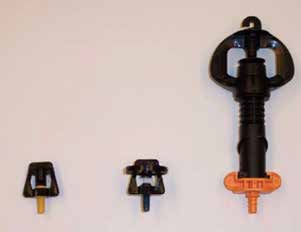
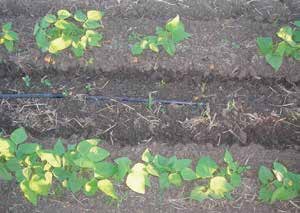
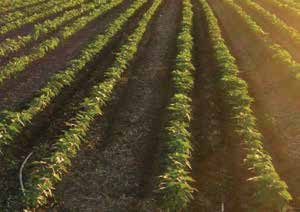
chAPter 17 Managing Water: irrigation and drainage
Drip irrigation systems are relatively inexpensive, can be
installed easily, use low pressure, and have low energy
consumption. In small-scale systems like market gardens,
pressure may be applied through a gravity hydraulic head
from a water container on the small platform. Subsurface
drip irrigation systems, in which the lines and emitters
are semipermanently buried to allow field operations, are
now also coming into use. Such systems require attention
to the placement of the tubing and emitters; they need to
be close to the plant roots, as lateral water flow from the
trickle line through the soil is limited.
Manual irrigation involves watering cans, buck-
ets, garden hoses, inverted soda bottles, etc. Although it
Figure 17.7. Small (micro) sprinklers al ow for localized water application at low cost. Photo by Thomas Scherer.
doesn’t fit with large-scale agriculture, it is still widely
used in gardens and small-scale agriculture in underde-
(figure 17.7) that are connected using small-diameter
veloped countries.
“spaghetti tubing” and relatively small pumps, making
Fertigation is an efficient method to apply fertil-
the system comparatively inexpensive.
izer to plants through pumped systems like sprinkler
Drip, or trickle, irrigation systems also use
and drip irrigation. The fertilizer source is mixed with
flexible or spaghetti tubing combined with small emitters.
the irrigation water to provide low doses of liquid
They are mostly used in bedded or tree crops using a line
fertilizer that are readily absorbed by the crop. This
source with many regularly spaced emitters or applied
also allows for “spoon feeding” of fertilizer to the crop
directly near the plant through a point-source emitter
through multiple small applications, which would other-
(figure 17.8). The main advantage of drip irrigation is the
wise be a logistical challenge.
parsimonious use of water and the high level of control.
Figure 17.8. Drip irrigation of bean plants. Lateral movement of water to reach plant roots may be limited with drip systems (left), unless each crop row has its own drip line or the spacing between rows is decreased by using narrow twin rows (right). Note: The apparent leaf discoloration is due to a low sun angle.
192
Building SoilS for Better CropS: SuStainaBle Soil ManageMent

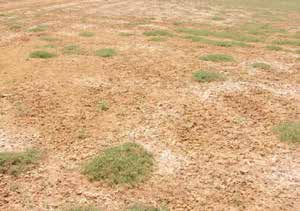
chAPter 17 Managing Water: irrigation and drainage
Figure 17.9. Over-irrigation can raise groundwater tables (visible at bottom of pit, left). Surface evaporation of water traveling upward through soil capillaries (very small channels) from the shal ow groundwater causes salt accumulation (right).
Environmental Concerns and Management Practices
lower soil horizons are also saline. Irrigation systems
Irrigation has numerous advantages, but significant con-
in arid regions should be designed to supply water and
cerns exist as well. The main threat to soil health in dry
also to remove water—implying that irrigation should
regions is the accumulation of salts—and in some cases
be combined with drainage. This may seem paradoxical,
also sodium. As salt accumulation increases in the soil,
but salts need to be removed by application of additional
crops have more difficulty getting the water that’s there.
water to dissolve the salts, leach them out of the soil,
When sodium accumulates, aggregates break down and
and subsequently remove the leachate through drains or
soils become dense and impossible to work (chapter
ditches, where the drain water may still create concerns
6). Over the centuries, many irrigated areas have been
for downstream areas due to its high salt content. One of
abandoned due to salt accumulation, and it is still a
the long-term success stories of irrigated agriculture—
major threat in several areas in the U.S. and elsewhere
the lower Nile Valley—provided irrigation during the
(figure 17.9). Salinization is the result of the evaporation
river’s flood stage in the fall and natural drainage after
of irrigation water, which leaves salts behind. It
it subsided to lower levels in the winter and spring. In
is especially prevalent with flood irrigation systems,
which tend to over-apply water and can raise saline
concerns WIth IrrIGAtIon
groundwater tables. Once the water table gets close to
• accumulation of salts and/or sodium in the soil
the surface, capillary water movement transports soil
• energy use
water to the surface, where it evaporates and leaves
• increased potential for nutrient and pesticide loss
salts behind. When improperly managed, this can
• water use diverted from natural systems
render soils unproductive within a matter of years.
• displacement of people by large dams and possible
Salt accumulation can also occur with other irrigation
flooding of productive cropland, wetlands, or
practices—even with drip systems, especially when the
archaeological sites
climate is so dry that leaching of salts does not occur
• competing users: urban areas and downstream
through natural precipitation.
communities
The removal of salts is difficult, especially when
193
Building SoilS for Better CropS: SuStainaBle Soil ManageMent
chAPter 17 Managing Water: irrigation and drainage
some cases, deep-rooted trees are used to lower regional
application rates and amounts can push nitrates and
water tables, which is the approach used in the highly
pesticides past the root zone and increase groundwater
salinized plains of the Murray Darling Basin in south-
contamination. Soil saturation from high application
eastern Australia. Several large-scale irrigation projects
rates can also generate denitrification losses.
around the world were designed only for the water sup-
A bigger issue with irrigation, especially at regional
ply component, and funds were not allocated for drain-
and global scales, is the high water consumption levels
age systems, ultimately causing salinization.
and competing interests. Agriculture consumes approxi-
The removal of sodium can be accomplished by
mately 70% of the global water withdrawals. Humans
exchange with calcium on the soil exchange complex,
use less than a gallon of water per day for direct con-
which is typically done through the application of gyp-
sumption, but about 150 gallons are needed to produce
sum. In general, salinity and sodicity are best prevented
a pound of wheat and 1,800 gallons are needed for a
through good water management. (See chapter 20 for
pound of beef (table 17.1, p. 188). According to the U.S.
discussion of reclaiming saline and sodic soils.)
Geological Survey, 68% of high-quality groundwater
Salt accumulation is generally not an issue in humid
withdrawals in the U.S. are used for irrigation. Is this
regions, but over-irrigation raises concerns about nutri-
sustainable? The famous Ogallala aquifer mostly holds
ent and pesticide leaching losses in these areas. High
“ancient” water that accumulated during previous wetter
climates. As mentioned above, withdrawals are currently
larger than the recharge rates, and this limited resource
is therefore slowly being mined.
Good IrrIGAtIon MAnAGeMent
Several large irrigation systems affect international
• Build soil to be more resistant to crusting and drought
relations. The high withdrawal rates from the Colorado
by increasing organic matter contents, aggregation,
River diminish it to a trickle by the time it reaches
and rooting volume.
the U.S.-Mexico border and the estuary in the Gulf
• Use water conservatively: Consider deficit irrigation
of California. Similarly, Turkey’s decision to promote
scheduling.
agricultural development through the diversion of
• Monitor soil, plant, and weather for precise estima-
Euphrates waters has created tensions with the down-
tion of irrigation needs.
stream countries, Syria and Iraq.
• Use precise water application rates; do not over-irrigate.
• Use water storage systems to accumulate rainfall
Irrigation Management at the Farm Level
when feasible.
Sustainable irrigation management and prevention of
• Use good-quality recycled wastewater when available.
salt and sodium accumulation require solid planning,
• Reduce tillage and leave surface residues.
appropriate equipment, and monitoring. A first step is
• Use mulches to reduce surface evaporation.
to build the soil so it optimizes water use by the crop. As
• Integrate water and fertilizer management to reduce
we discussed in chapters 5 and 6, soils that are low in
losses.
organic matter and high in sodium have low infiltration
• Prevent salt or sodium accumulation: Leach salt
capacities due to surface sealing and crusting from low
through drainage, and reduce sodium contents
aggregate stability. Overhead irrigation systems often
through gypsum application.
apply water as “hard rain,” creating further problems
with surface sealing and crusting.
194
Building SoilS for Better CropS: SuStainaBle Soil ManageMent
chAPter 17 Managing Water: irrigation and drainage
Healthy soils have more water supply capacity than
Table 17.2
soils that are compacted and depleted of organic matter.
Plant-Available Water Capacity in Long-Term Tillage and
Rotation Experiments in New York
It is estimated that for every 1% loss in organic matter
Tillage Experiments
Plant-Available Water Capacity (%)
content in the surface foot, soil can hold 16,500 gallons
Plow till
No till
% increase
less of plant-available water per acre. Additionally, sur-
face compaction creates lower root health and density,
Silt loam—33 years
24.4
28.5
17%
and hard subsoils limit rooting volume. These processes
Silt loam—13 years
14.9
19.9
34%
are captured by the concept of the optimum water
Clay loam—13 years
16.0
20.2
26%
range—which we discussed in chapter 6—where the com-
Rotation
Continuous
Experiment
corn
Corn after grass % increase
bination of compaction and lower plant-available water
Loamy sand—12 years
14.5
15.4
6%
retention capacity limits the soil water range for healthy
Sandy clay—12 years
17.5
21.3
22%
plant growth. Such soils therefore have less efficient crop
Source: Moebius et al. (2008).
water use and require additional applications of irrigation
water. In fact, it is believed that many farms in humid cli-
rainfall events. Building a healthier soil will reduce
mates have started to use supplemental irrigation because
irrigation needs and conserve water, because increased
their soils have become compacted and depleted of
plant water availability extends the time until the onset
organic matter. As we discussed before, poor soil manage-
of drought stress and greatly reduces the probability of
ment is often compensated for by increased inputs.
stress. For example, let’s assume that a degraded soil
Reducing tillage, adding organic amendments,
with a plow pan (A) can provide adequate water to a
preventing compaction, and using perennial
crop for 8 days without irrigation, and a healthy soil
crops in rotations can increase water storage. A long-
with deep rooting (B) allows for 12 days. A 12-day con-
term experiment showed that reducing tillage and using
tinuous drought, however, is much less likely. Based on
crop rotations increased plant-available water capacity
climate data for the northeastern U.S., the probability of
in the surface horizon by up to 34% (table 17.2). When
such an event in the month of July is 1 in 100 (1%), while
adding organic matter, consider stable sources that are
the probability for an 8-day dry period is 1 in 20 (5%).
mostly composed of “very dead” materials such as com-
The crops growing on soil A would run out of water and
posts. They are more persistent in soil and are a primary
suffer stress in July in 5% of years, while the crops on
contributor to soil water retention. But don’t forget fresh
soil B would be stressed in only 1% of years. A healthy
residues (the “dead”) that help form new and stable
soil would reduce or eliminate the need for irrigation in
aggregates. Increasing rooting depth greatly increases
many cases.
plant water availability by extending the volume of soil
Increasing surface cover— especially with heavy
available for roots to explore. When distinct plow pans
mulch—significantly reduces evaporation from the soil
are present, ripping through them makes subsoil water
surface. Cover crops can increase soil organic










